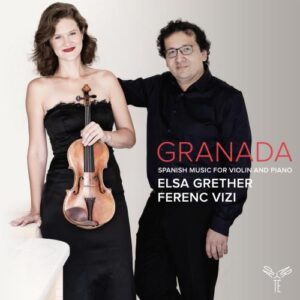
Elsa Grether & Ferenc Vizi, Granada: Spanish Music for Violin and Piano Review
Granada: Spanish Music for Violin and Piano presents a rich and evocative exploration of Spanish classical music through the combined artistry of violinist Elsa Grether and pianist Ferenc Vizi. This album, released in April 2025, is a personal tribute by Grether to her Spanish heritage, woven into a program of popular and seldom-recorded works. The pairing of Grether’s nuanced violin interpretations with Vizi’s expressive piano artistry brings new life to Spanish musical traditions, blending folk-inspired melodies with early 20th-century modernist expressions.
Elsa Grether has earned international recognition for her emotive performances, both in solo recitals and as part of chamber music ensembles. Her ability to create nuanced interpretations of classical works has garnered accolades from critics worldwide. Ferenc Vizi, a pianist of exceptional versatility, is celebrated for his deep emotional engagement with the Romantic and 20th-century repertoire. Together, their dynamic partnership on this album offers an impressive combination of technical prowess and intimate musical expression.
The late 19th and early 20th centuries marked a significant period in Spanish nationalism in classical music, where composers began to integrate Iberian folk traditions into their compositions. Spanish classical music, during this era, often fused native melodic lines, rhythms, and dances with the forms and harmonies of European art music, creating a distinct identity that reflected the country’s cultural history. The violin and piano duo format, while traditionally seen as a chamber music staple, is particularly well-suited for conveying the emotional intensity and intricate rhythms of Spanish music.
The album’s program offers familiar gems and hidden treasures, blending works that have become staples in the classical repertoire with pieces that are rarely recorded, providing a fascinating contrast. This curatorial insight reflects Grether’s personal homage to Spanish music, serving as an artistic rediscovery and a celebration of Spain’s diverse cultural landscape. The program choices expertly balance the joy and vibrancy of Spanish folk traditions with the introspection and complexity of 20th-century modernism.
The opening track, Andalucia (Seguidilla Española) by Joaquín Nin, is a rhythmic tour de force, capturing the essence of Andalusian folk music. Grether’s violin mimics the vocal nuances of the flamenco tradition, weaving through the piece with a deeply expressive tone, while Vizi’s piano provides clear rhythmic articulation that drives the piece’s dance-like energy. Together, they create a vivid snapshot of southern Spain’s musical landscape.
Turina’s El poema de una sanluqueña offers a wide emotional range, from lyrical delicacy to passionate intensity. The violinist’s expressive phrasing and technical control shine through in the piece’s contrasting movements. In “La canción de la rosa,” Grether’s phrasing is soft and contemplative, drawing the listener into an introspective journey, while “El fantasma de la jabera” demonstrates the work’s darker, more complex side, with the performers capturing the piece’s drama and emotional depth.
Rodrigo’s Sonata pimpante is an exploration of lively rhythms and harmonic inventiveness. Grether and Vizi approach the piece with a sense of playful spontaneity, reflecting Rodrigo’s sense of joy and freedom. Grether’s keen sensitivity to Rodrigo’s harmonic language enhances the work’s brilliance, while Vizi’s pianistic clarity brings out the rhythmic vitality of the piece’s more intricate sections.
The selections from Falla’s El amor brujo and Siete canciones populares españolas are where the album truly comes alive with Spanish folk influence. The arrangement by Kochanski takes these originally vocal works and transforms them into rich violin and piano duets, preserving their emotional core. Grether’s violin sings through the beloved melodies, notably in the pieces “Asturiana,” “Nana,” and “Polo.” Vizi’s piano accompaniment provides the rhythmic grounding necessary to evoke the dances and emotional depth found in Falla’s music, capturing the essence of Spanish folk culture with precision.
Sarasate’s Carmen Fantasy is a showpiece of violin virtuosity. Grether’s performance brings new light to this iconic piece, showcasing her technical mastery and expressive range. Her execution of the intricate passages is flawless, with impeccable intonation and a refined sense of phrasing. Her ability to navigate the rapid changes in mood and tempo while maintaining emotional depth is a testament to her artistry. Vizi complements her perfectly, providing a strong foundation and the necessary sparkle in the piano accompaniment.
The closing piece, Montsalvatge’s Canción de cuna para dormir un negrito, offers a moment of lyrical intimacy. Grether’s violin tone is warm and delicate, capturing the song’s lullaby-like quality, while Vizi’s piano provides a gentle, supportive texture. The subtle interplay between the two performers highlights their sensitivity to the piece’s emotional delicacy, bringing the album to a poignant and introspective close.
Grether’s violin technique throughout the program is exceptional. Her bow control allows for a vast coloristic range, particularly in lyrical passages where she draws out the emotional depth of each piece. In virtuosic sections, such as Carmen Fantasy, her precision and agility are on full display, providing a stunning contrast to the more intimate moments in the program.
Vizi’s role as the pianist is indispensable. His dynamic sensitivity and ability to articulate complex rhythms ensure that the piano always serves as a complement to the violin, never overshadowing it. In works like El poema de una sanluqueña, where rhythmic clarity is paramount, Vizi’s articulation keeps the structure intact while allowing the violin to soar above. Together, their ensemble dynamics are seamless—both performers are attuned to each other’s phrasing, creating a unified vision in each piece.
The acoustic quality of the recording enhances the natural timbres of both instruments, capturing their warmth and clarity. The soundstage is well-balanced, allowing each instrument to be heard with clarity, yet maintaining a sense of unity between the violin and piano. The production captures the nuances of both performers’ phrasing and dynamics, ensuring that the subtleties of their interpretations are preserved in the recording. The detailed attention to acoustics allows listeners to appreciate the full breadth of Grether and Vizi’s expressive capabilities.
Granada: Spanish Music for Violin and Piano makes a significant contribution to the recorded repertoire of Spanish music for violin and piano. By introducing rarely performed works like Rodrigo’s Sonata pimpante and Turina’s El poema de una sanluqueña, the album broadens the scope of what is accessible within this genre. Including familiar pieces, such as Falla’s Siete canciones populares españolas and Sarasate’s Carmen Fantasy, offers listeners new interpretations of these beloved works, making the album valuable for historical and contemporary perspectives.
In comparison with historic recordings of these pieces, Grether and Vizi’s interpretations bring a fresh voice to the material. Their performances highlight the rich textures of the works while offering a sense of modernity and immediacy that sets their renditions apart from previous recordings. This album is an essential addition to the discography of Spanish classical music, providing new insights and a reverence for the past.
Granada: Spanish Music for Violin and Piano is a program of interpretation, technical excellence, and cultural authenticity. Elsa Grether and Ferenc Vizi have crafted an album that resonates with emotional depth while showcasing the rich textures of Spanish classical music. The program is thoughtfully curated, blending popular works with lesser-known gems, and the performers’ technical prowess and interpretative sensitivity bring each piece to life with clarity and passion. This album is highly recommended for listeners seeking new repertoire and those in search of exemplary interpretations


